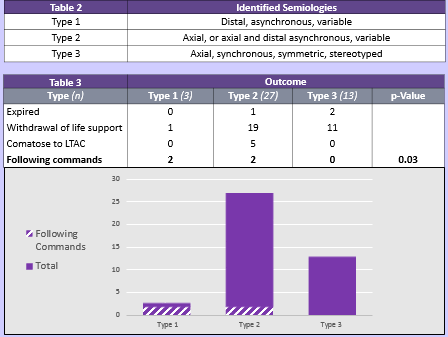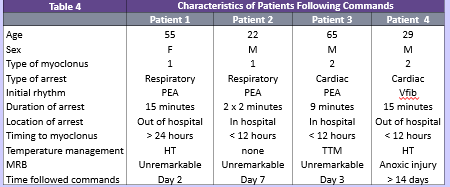Presenting Author:
Yara Mikhaeil-Demo , M.D.
Principal Investigator:
Elizabeth Gerard , M.D.
Department:
Neurology, Ken and Ruth Davee Department
Keywords:
myoclonic status, cardiac arrest
Location:
Ryan Family Atrium, Robert H. Lurie Medical Research Center
C57 - Clinical
Clinical Classification of Post Anoxic Myoclonic Status
Introduction: Despite decades of research into the prognostic significance of post-anoxic myoclonic status (MS), no consistent definition has been used to describe its clinical features. We set out to characterize the clinical features of MS and hypothesized that there are distinct clinical subtypes that may have different prognostic implications. Methods: We searched video EEG records at our institution for patients who had MS from 2008 to 2016. Inclusion criteria were age > 18 years, cardiopulmonary arrest, and myoclonus starting in coma. To generate our definitions of the clinical features of MS, we reviewed 23 cases and characterized 3 distinct clinical semiologies. An additional 20 cases were independently reviewed and categorized by 3 raters to evaluate the inter-rater agreement (IRA). All 43 patients were assigned to a group based on consensus review for the first 23 patients or majority agreement for IRA patients. We also examined the relationship between semiology, outcome and other clinical variables. Results: We identified 3 distinct clinical semiologies of MS: Type 1: distal, asynchronous, variable myoclonus; type 2: axial, asynchronous, variable myoclonus; and type 3: axial, synchronous, stereotyped myoclonus. For IRA, Gwet’s kappa was 0.64 indicating substantial agreement between raters. A greater percentage of type 1 (66.6%) and type 2 (7.4%) patients followed commands as compared to type 3 (0%)(P: 0.03). Conclusion: We defined and validated a classification system of MS with substantial agreement among 3 raters. Additionally, there was a statistically significant difference in outcome between the groups. We suspect that MS is clinically heterogeneous with subtypes that may carry prognostic significance.


